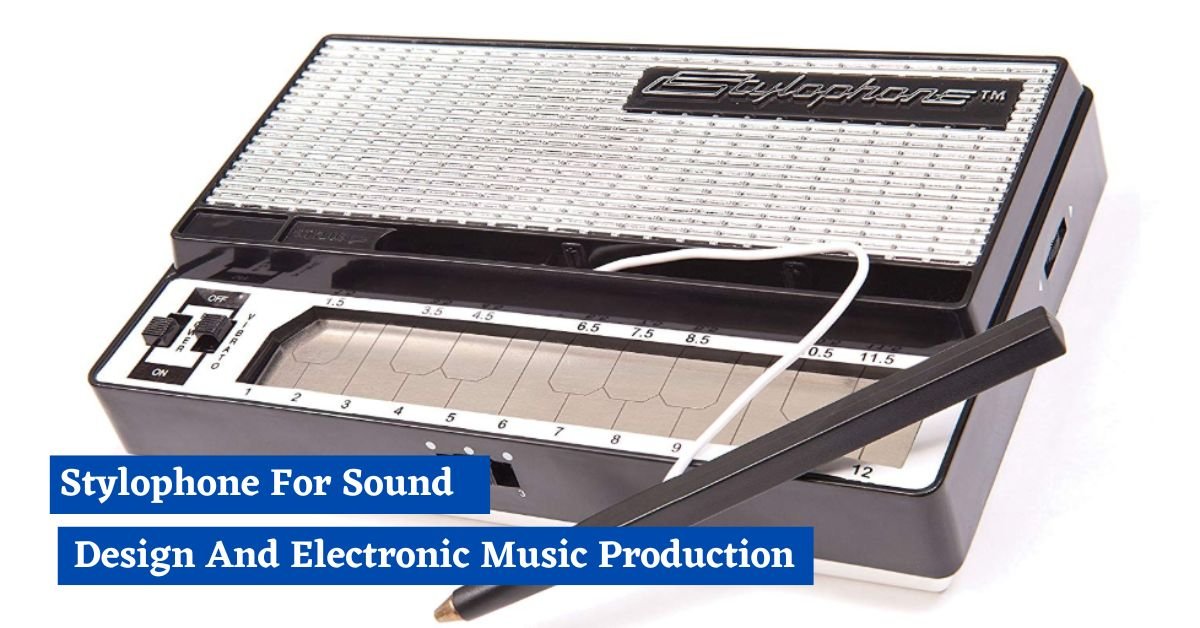Stylophones are versatile instruments used in sound design and electronic music production. They offer unique and captivating sounds, making them popular among musicians and producers seeking to create innovative melodies and textures in their compositions.
What is a Stylophone?
The Stylophone is a handheld electronic keyboard instrument that was first introduced in the 1960s. It consists of a metal keyboard played by touching a stylus or pen-like object onto the surface of the keys. This unique method of playing gives the Stylophone its name and distinct character.

The History of the Stylophone
Originally invented by Brian Jarvis and manufactured by Dubreq, the Stylophone gained popularity in the 1960s and became a cultural icon of the time. It was famously featured in David Bowie’s hit song “Space Oddity,” adding a futuristic and otherworldly sound to the track. Over the years, the Stylophone has gone through various iterations, improvements, and re-releases, solidifying its place in the music world.
Stylophone Features and Functionality
The Stylophone offers several features and functionalities that make it a powerful tool for sound design and electronic music production:
- Portable and Compact Design: The Stylophone’s compact size and lightweight nature make it highly portable, allowing musicians and producers to take it anywhere for on-the-go creativity.
- Keyboard and Note Selection: The metal keyboard of the Stylophone offers a range of notes to play, giving musicians the ability to create melodies, chords, and riffs easily.
- Built-in Effects and Sound Options: Depending on the model, the Stylophone may include built-in effects such as vibrato, tremolo, and reverb, as well as various sound options, allowing users to experiment with different textures and sonic possibilities.
- Connectivity and Integration: Many modern versions of the Stylophone feature connectivity options like MIDI and USB, enabling seamless integration with computers, DAWs (Digital Audio Workstations), and other MIDI-compatible devices.
Using the Stylophone for Sound Design
The Stylophone offers a myriad of possibilities for sound design. Here are some ways you can utilize this instrument to create unique and captivating sounds:
- Creating Unique Melodies and Riffs: The distinctive sound of the Stylophone can add an original touch to melodies and riffs, making them stand out in a mix and leaving a lasting impression on the listener.
- Exploring Different Sound Textures: By experimenting with the various sound options and effects available on the Stylophone, you can explore different sound textures and create unconventional sonic landscapes.
- Experimenting with Effects and Filters: The built-in effects and filters on certain Stylophone models can be manipulated to create dynamic and evolving sounds. From subtle modulation to more pronounced filtering, the possibilities are endless.
- Layering and Mixing Sounds: The Stylophone can be used in conjunction with other instruments and sound sources to create complex and layered compositions. By blending the Stylophone’s unique timbre with other elements, you can achieve a rich and multifaceted sonic palette.

Stylophone in Electronic Music Production
The Stylophone has found a special place in the world of electronic music production. Here are some ways in which it can enhance your electronic music projects:
- Incorporating the Stylophone in Tracks: Whether you’re producing synthwave, electro-pop, or experimental electronic music, incorporating the Stylophone can infuse your tracks with a retro and nostalgic vibe.
- Adding Vintage and Retro Elements: The distinctive sound of the Stylophone harks back to the analog era of electronic music. By utilizing this instrument, you can add vintage and retro elements to your compositions, giving them a timeless quality.
- Collaborating with Other Instruments: The Stylophone can seamlessly blend with other electronic instruments and hardware synths, allowing for collaborative and harmonious performances. Its unique sound can complement and enhance other sound sources, leading to interesting and captivating musical journeys.
- Live Performances and Stage Presence: The portable nature of the Stylophone makes it an excellent choice for live performances. Its visual appeal, combined with its distinctive sound, can captivate the audience and add an element of surprise and excitement to your shows.
Famous Artists and Tracks Utilizing the Stylophone
Over the years, the Stylophone has been featured in numerous famous tracks and utilized by renowned artists. Here are a few examples:
- David Bowie and “Space Oddity”: David Bowie’s iconic song “Space Oddity” prominently features the Stylophone, contributing to the track’s atmospheric and otherworldly feel. This song played a significant role in popularizing the instrument.
- Kraftwerk and Electronic Pioneers: The influential electronic band Kraftwerk incorporated the Stylophone into their groundbreaking music, exemplifying the instrument’s potential for creating futuristic and forward-thinking sounds.
- Modern Artists and Genres: From indie rock bands to electronic music producers, the Stylophone continues to find its way into various contemporary genres, bringing a unique and captivating sonic character to modern productions.
Tips for Choosing and Using a Stylophone
If you’re considering adding a Stylophone to your music setup, here are a few tips to help you make the best choice and get the most out of the instrument:
- Consider Your Musical Style and Goals: Think about the type of music you create and the role you envision the Stylophone playing in your compositions. This will help you choose a model that aligns with your musical style and goals.
- Budget and Features: Determine your budget and research different Stylophone models to find the one that offers the features and functionalities you need without breaking the bank. Consider factors like sound options, effects, connectivity, and build quality.
- Practice and Experimentation: Like any instrument, mastering the Stylophone requires practice and experimentation. Spend time familiarizing yourself with its nuances, exploring its capabilities, and pushing its boundaries to unlock your creative potential.
What are Stylophones used for?
Stylophones are used for a variety of purposes in music production and sound design. They are popular among musicians, producers, and enthusiasts for creating unique melodies, exploring different sound textures, and adding a retro touch to compositions. Stylophones can be utilized in various genres, including electronic music, synthwave, and experimental music. Their portability and distinctive sound make them an excellent tool for live performances as well.

What famous songs use a Stylophone?
One of the most famous songs that prominently features a Stylophone is David Bowie’s “Space Oddity.” The haunting and ethereal sound of the Stylophone adds a distinct character to the track, contributing to its atmospheric quality. Additionally, the influential electronic band Kraftwerk incorporated the Stylophone into their music, showcasing its potential for creating futuristic and innovative sounds. The Stylophone’s presence can also be found in modern tracks across various genres.
How does the Stylophone produce sound?
The Stylophone produces sound through a simple yet effective mechanism. It consists of a metal keyboard that is played by touching a stylus or pen-like object onto the surface of the keys. When the stylus makes contact, it completes an electrical circuit, generating an electric signal. This signal is then amplified and converted into audible sound through the built-in speaker or outputted to external devices for further processing and manipulation.
Is the Stylophone hard to learn?
The Stylophone’s intuitive design makes it relatively easy to learn, especially for beginners. Its simplified keyboard layout and the stylus-based playing method require minimal technical knowledge or dexterity. With practice and experimentation, users can quickly familiarize themselves with the instrument’s capabilities and unlock their creative potential. While mastering any instrument takes time and dedication, the Stylophone’s user-friendly nature ensures that aspiring musicians can start creating captivating sounds and melodies without significant difficulty.
FAQs
Can I connect the Stylophone to my computer or DAW?
Yes, many modern Stylophone models come with MIDI and USB connectivity options, allowing seamless integration with your computer or DAW.
Is the Stylophone suitable for beginners?
Absolutely! The Stylophone’s intuitive design makes it accessible for beginners. With practice, you can quickly start creating unique sounds and melodies.
Can I use the Stylophone for live performances?
Yes, the Stylophone’s portable and visually appealing design makes it an excellent choice for live performances, adding an exciting element to your stage presence.
Are there different variations of the Stylophone available?
Yes, over the years, various versions and models of the Stylophone have been released, offering different features and functionalities. Research and choose the one that suits your needs.
Can the Stylophone be used in genres other than electronic music?
Absolutely! While the Stylophone is commonly associated with electronic music, its unique sound can be incorporated into various genres, adding a distinct flavor to your compositions.
Conclusion
The Stylophone is a versatile and unique instrument that holds a special place in the realm of sound design and electronic music production. With its distinctive sound, compact design, and rich history, it offers endless possibilities for creating captivating melodies, exploring textures, and adding a retro touch to your compositions. Whether you’re a musician, producer, or sound enthusiast, the Stylophone is a valuable addition to your creative arsenal.


